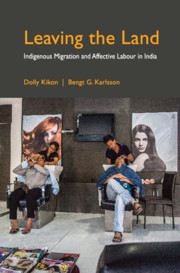Introduction
Published online by Cambridge University Press: 04 May 2019
Summary
Ours is a century of uprootedness. All over the world, fewer and fewer people live out their lives in the place where they were born.
– Michael Jackson, At Home in the World, 1995In the last decade, the migration of indigenous youths from the uplands of Northeast India to metropolitan cities across India has become one of the most significant social and economic transformations of the region. Since India's independence, the region has captured the limits of India's cultural and political imagination, and its citizens and histories have been refracted through the prism of militarization and an extractive resource regime. In this book, we examine the increasing trend of migration among indigenous youths from Northeast India and illustrate how these movements offer us new insights about the insecurities, desires, and expectations among indigenous citizens in global India.
Until recently, the journey of young indigenous migrants who travel across metropolitan cities in India, constantly looking for new employment possibilities and opportunities, was unthinkable. Indigenous mobility in the highlands of Northeast India was associated with jhum at best, and with violent ethnic conflicts at worst. In addition, the imagination of indigenous people as attached to their land to be able to inhabit their culture and history was a powerful one. Therefore, the experiences of indigenous migrants we highlight in this book offer a new trajectory about citizenship, mobility, and indigenous experiences in contemporary India. By interrogating the myth of isolation, insularity, and remoteness that has defined Northeast India, we present the struggles, aspirations, and vulnerabilities of young indigenous migrants who constitute the underbelly of the service industry in global India today. The presence of young indigenous migrants, once regarded as savages, backward, and primitive, and their experiences in this book draws our attention towards new ways of generating a theoretical framework about the everyday experiences of a section of the population previously categorized as ‘simple’ and ‘childlike’ and disqualified from having elaborate ideas about serious and sophisticated matters in contemporary India. People from Northeast India have also earlier moved to the Indian mainland to work, for example, as civil servants in various government departments or as soldiers in the Indian army. Yet the large-scale migration of young people we account for here is a different and novel phenomenon.
- Type
- Chapter
- Information
- Leaving the LandIndigenous Migration and Affective Labour in India, pp. 1 - 25Publisher: Cambridge University PressPrint publication year: 2019

